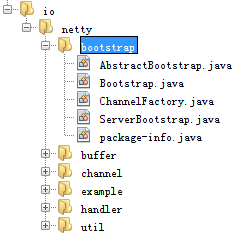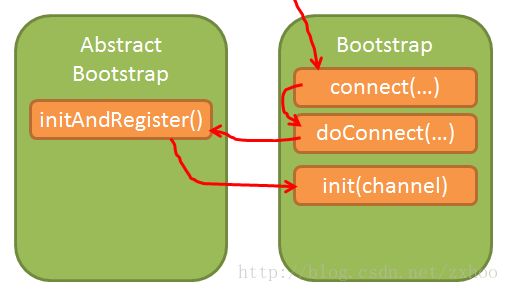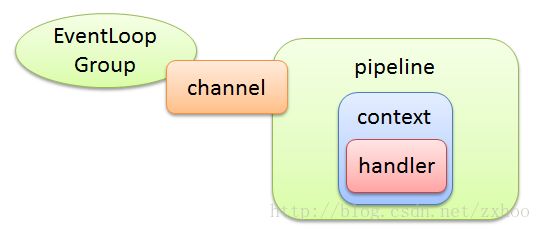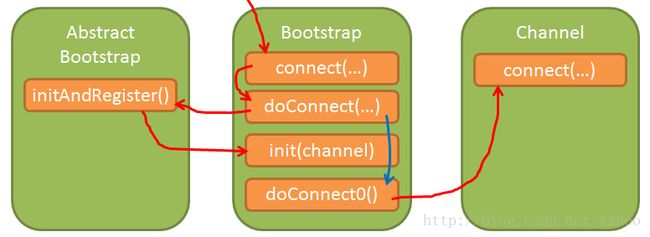Netty4学习笔记(2)-- Bootstrap
Netty4的代码比我想象的要复杂的多,不过Netty4很好的将这种复杂性隐藏了起来,暴露出来的,是一个相对容易使用的接口。Bootstrap就是Netty试图隐藏这种复杂性的一个例子。
bootstrap包
Bootstrap继承结构
AbstractBootstrap是抽象类,有两个具体的实现,Bootstrap和ServerBootstrap:Bootstrap例子
Netty4自带的例子里有一个EchoClient,看看它是如何使用Bootstrap启动一个客户端程序的:public class EchoClient {
private final String host;
private final int port;
private final int firstMessageSize;
public EchoClient(String host, int port, int firstMessageSize) {
this.host = host;
this.port = port;
this.firstMessageSize = firstMessageSize;
}
public void run() throws Exception {
// Configure the client.
EventLoopGroup group = new NioEventLoopGroup();
try {
Bootstrap b = new Bootstrap();
b.group(group)
.channel(NioSocketChannel.class)
.option(ChannelOption.TCP_NODELAY, true)
.handler(new ChannelInitializer() {
@Override
public void initChannel(SocketChannel ch) throws Exception {
ch.pipeline().addLast(
//new LoggingHandler(LogLevel.INFO),
new EchoClientHandler(firstMessageSize));
}
});
// Start the client.
ChannelFuture f = b.connect(host, port).sync();
// Wait until the connection is closed.
f.channel().closeFuture().sync();
} finally {
// Shut down the event loop to terminate all threads.
group.shutdownGracefully();
}
}
public static void main(String[] args) throws Exception {
// ...
}
} Builder模式?
看上面的例子,Bootstrap的使用很像Builder模式,Bootstrap就是Builder,EventLoopGroup、Channel和Handler等是各种Part。稍有不同的是,准备好各种Part后,并不是直接build出一个Product来,而是直接通过connect()方法使用这个Product。
AbstractBootstrap
为了弄清楚Bootstrap如何工作,我们先从AbstractBootstrap入手:
public abstract class AbstractBootstrap, C extends Channel> implements Cloneable {
private volatile EventLoopGroup group;
private volatile ChannelFactory channelFactory;
private volatile SocketAddress localAddress;
private final Map, Object> options = new LinkedHashMap, Object>();
private final Map, Object> attrs = new LinkedHashMap, Object>();
private volatile ChannelHandler handler;
// ...
} 可以看到,AbstractBootstrap这个抽象Builder一共需要有6个Part,如下图所示:
设置各个Part
AbstractBootstrap有一组方法用来设置各个Part,例如下面这些:
public B group(EventLoopGroup group)
public B channel(Class channelClass)
public B channelFactory(ChannelFactory channelFactory)
public B localAddress(SocketAddress localAddress)
public B option(ChannelOption option, T value)
public B attr(AttributeKey key, T value)
public B handler(ChannelHandler handler)
还有一组对应方法获得各个Part,如下:
final SocketAddress localAddress()
final ChannelFactory channelFactory()
final ChannelHandler handler()
public final EventLoopGroup group()
final Map, Object> options()
final Map, Object> attrs() ChannelFactory
AbstractBootstrap通过ChannelFactory创建Channel实例,channel(channelClass)方法看起来好像是设置了一个Channel,但实际上只是设置了默认的ChannelFactory实现:
public B channel(Class channelClass) {
if (channelClass == null) {
throw new NullPointerException("channelClass");
}
return channelFactory(new BootstrapChannelFactory(channelClass));
} 默认的ChannelFactory实现使用反射创建Channel实例:
private static final class BootstrapChannelFactory implements ChannelFactory {
private final Class clazz;
BootstrapChannelFactory(Class clazz) {
this.clazz = clazz;
}
@Override
public T newChannel() {
try {
return clazz.newInstance();
} catch (Throwable t) {
throw new ChannelException("Unable to create Channel from class " + clazz, t);
}
}
} Bootstrap.connect()
再来看Bootstrap类的connect()方法:
public ChannelFuture connect(SocketAddress remoteAddress, SocketAddress localAddress) {
if (remoteAddress == null) {
throw new NullPointerException("remoteAddress");
}
validate();
return doConnect(remoteAddress, localAddress);
}connect()方法调用validate()方法看各个Part是否准备就绪,然后调用doConnect()方法:
private ChannelFuture doConnect(final SocketAddress remoteAddress, final SocketAddress localAddress) {
final ChannelFuture regFuture = initAndRegister();
final Channel channel = regFuture.channel();
if (regFuture.cause() != null) {
return regFuture;
}
final ChannelPromise promise = channel.newPromise();
if (regFuture.isDone()) {
doConnect0(regFuture, channel, remoteAddress, localAddress, promise);
} else {
regFuture.addListener(new ChannelFutureListener() {
@Override
public void operationComplete(ChannelFuture future) throws Exception {
doConnect0(regFuture, channel, remoteAddress, localAddress, promise);
}
});
}
return promise;
}doConnect()方法首先调用了initAndRegister()方法,然后又调用了doConnect0()方法,方法调用示意图如下:
AbstractBootstrap.initAndRegister()
final ChannelFuture initAndRegister() {
final Channel channel = channelFactory().newChannel();
try {
init(channel);
} catch (Throwable t) {
channel.unsafe().closeForcibly();
return channel.newFailedFuture(t);
}
ChannelPromise regPromise = channel.newPromise();
group().register(channel, regPromise);
// ...
}而Channel在实例化的时候已经自动关联了Pipeline,这点从AbstractChannel的构造函数可以看出:
protected AbstractChannel(Channel parent) {
this.parent = parent;
unsafe = newUnsafe();
pipeline = new DefaultChannelPipeline(this);
}Bootstrap.init()方法
void init(Channel channel) throws Exception {
ChannelPipeline p = channel.pipeline();
p.addLast(handler());
// ...
}继续Bootstrap.doConnect()
initAndRegister()方法结束之后,doConnect()方法紧接着调用了doConnect0()方法,doConnect0()方法继而调用了Channel.connect()方法,这样Channel就接通服务器,可以收发消息了!







